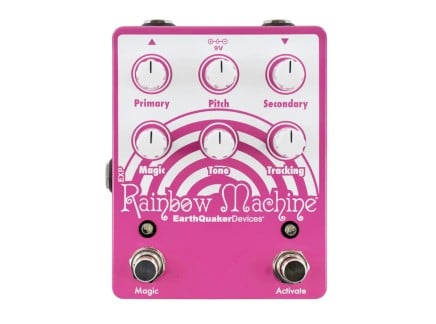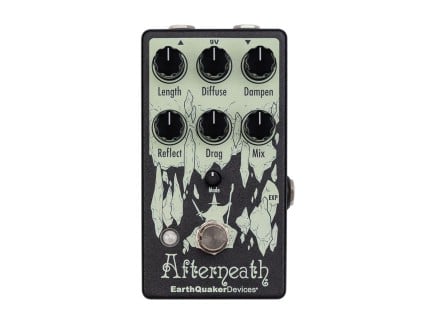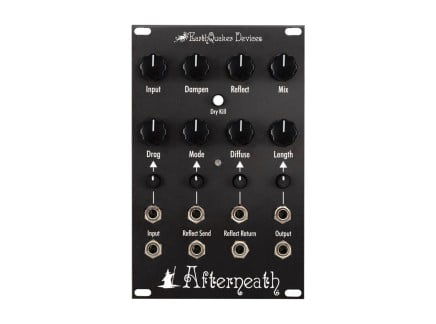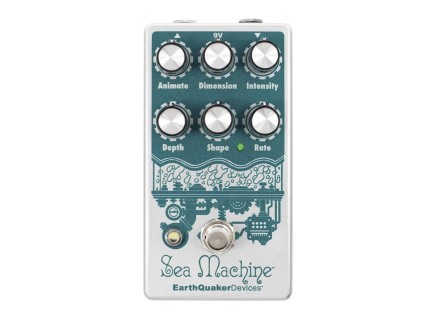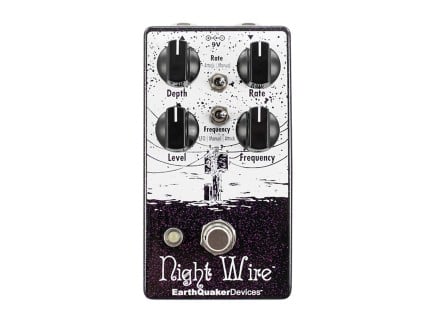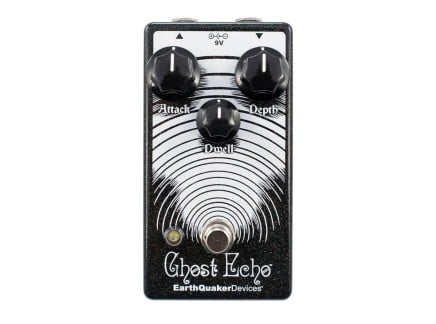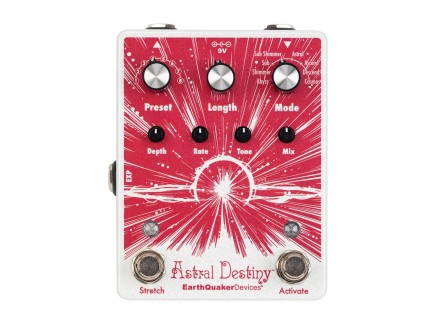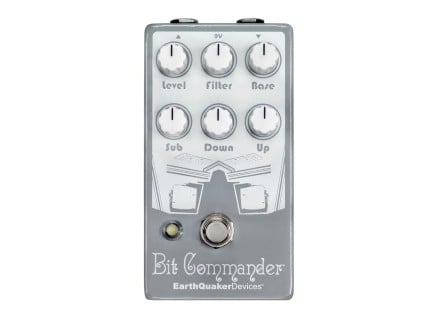Earthquaker Devices has multiple identities: on one hand, they are a boutique designer of classic fuzz and dirt guitar effects pedals...but on the other, they create outrageous tools for sonic destruction, ambient exploration, and inspired, detailed sound design. Owner/designer Jamie Stillman has consistently expressed that the company's overall trajectory has been guided by his personal curiosity...and given his overall imaginative approach to electronics and sound design, they've become a staple company for everyone from guitarists to keyboardists and modular synth enthusiasts.
Earthquaker's product line is extensive, and in use, many of their designs offer considerably greater depth than a spec sheet alone can explain. As such, we decided to take a closer look at our personal favorite EQD pedals. It's worth noting that the Signal staff writers are all quite different musicians from one another: collectively, we play a wide range of instruments and make everything from all-electronic dance music to eclectic ambient soundscapes...so we don't exclusively approach these pedals as guitarists. Instead, we see them as powerful tools for sound design—tools that can benefit modular synthesists, keyboardists, in-the-box producers, noise artists, and much more. So without further delay, let's get started analyzing our favorite EQD designs for transforming sound.
Brian's Picks: Avalanche Run + Rainbow Machine
Earthquaker Devices has made a name for themselves by creating unique effects that can dial in a wide array of sounds from very subtle to over-the-top. Two of their effects that have become beloved staples in many musicians' respective arsenals are the Avalanche Run and Rainbow Machine. Both can be used in highly creative ways to add a dusting of spice or a veritable cornucopia of delights. These pedals excel when thrown into an effects chain and work exceptionally well when paired together. Let's look at a few settings that can get you started or pique your interest—of course these are all just starting points and exploration is a must to truly understand how these can work in your own practice.
Whether you're an ambient zoner, textural droner, or just like a nice tone(r), delay => reverb is a classic combination for creating ethereal landscapes, subtle flair, and dosed sounds. With good reason, too: the reverb can smooth out percussive sounds, or accentuate them depending on its size. Delay can similarly smear when fast enough or create haunted phrases that come back seconds later. Both of these effects are inspired by natural phenomena and so you can create illusory spaces that are somewhat realistic or feel extraterrestrial. Earthquaker noticed this common effect chain and threw it all into one pedal, the Avalanche Run, which can be either effect or both. The basics are covered in many other places, so we're going to focus on a few specific, unique uses for this pedal.
The first setting we're going to look at is the Swell setting on the reverb. While in the setting the Mix knob adjusts the length of the swell with longer waves happening as you turn up. This works really beautifully when paired with another effect either before or after to create abstract shapes. When using a pitch effect, perhaps like the Rainbow Machine, in front of it with a large reverb, lots of delay, and a long swell, you can get exceptional pad tones. While these pedals may have started with a guitar or instrument in mind, this particular setting and signal flow can create some very interesting sounds when used with samples and by bombarding the input with audio. The Avalanche Run, then, never has a true chance to completely close but will try, creating interesting amplitude fluctuations. What personally impressed me the most is the stability of the audio while bombarding it with streams of sound—everything it created sounded musical: the beauty of the delay and reverb combination.
We're going to skip over the Normal setting, which offers more traditional delay performance, but suffice to say: it sounds great. Instead, let's take a peek at the Reverse setting. This only applies to the delay section of the pedal leaving the reverb intact and is exceptionally helpful for eerie sounds. Using voice samples, especially when pitched down, is a fairly common tactic for generating uneasy feelings; reversed voices have a similar effect. By feeding the Avalanche Run voice samples and using the two independent Mix knobs, you can play with the amount of forward or reversed voice and get interesting layers of strange sounds. If you're using stereo samples and a sampler, try sending the left and right channels to different filters and modulate the cutoff for satisfying spatial effects. You can get weirder by using the expression pedal input to modulate the delay mix for swimming sounds, or the Reverb Decay time for strange time warps. Earthqaker's EXP input can also accept voltages up to about 3.3v, you just have to use a TRS - 2x TS splitter with the Ring going into the input of a VCA and the Tip going from the output.
Of course, a discussion about Earthquaker's greatest sonic achievements wouldn't be complete without a close look at the Rainbow Machine—a pitch shifting delay infused with all sorts of peculiar magic and mystery. This is an advanced pedal that can easily become quite effervescent, but it sparkles even brighter when dialed in tastefully and with finesse. We're first going to focus simply on one of the most evergreen uses for the Rainbow Machine—and that is as a chorus pedal. Taken directly from their website, you pretty much plop everything at noon with the Magic disengaged and you have a very nice chorus: adjust the Pitch very little in either direction to effectively adjust the depth—as it would be called on a traditional chorus pedal. This serves as a great place to start exploring and I would suggest turning the Pitch knob a small amount in either direction—then adjust the Primary, Secondary, and Tracking to taste. With the Tracking knob, you can actually get a warped delay sound and the Secondary knob dials in a second shifted pitch opposite the direction of the pitch knob...great for adding extra thickness and swirling detuning to this chorus effect.
Using quick sounds, either percussive hits or bubbly, fast envelopes, yields satisfying results; by giving the Rainbow Machine less audio to smear you gain more control and the effects feels more like a small dusting. Coupling this with a nice delay, reverb, or both gives you a fantastic pad sound. Throw this in front of the Avalanche Run in its Swell setting and you can get really exceptional dimensional teleportation. In this setup, the Magic control can be used quite musically by riding the knob and artfully dis/engaging the footswitch. Using this technique requires a fair amount of concentration and a hands-on approach, but the rewards are worth the dedication, like any instrument worth pursuing. After you've grown comfortable with the quirks of this pedal, try putting a slow evolving drone through the Rainbow Machine and use this same technique, this time riding the Magic, Tracking, and the Magic footswitch. For extra weirdness, patch a random source into the EXP input (check out this article for advice on how best to make this connection)—Pam's Pro Workout and Tangle Quartet work great to dial in the right amount of modulation for the Rainbow Machine...and Avalanche Run, for that matter.
Another quick tip: Tonal material works great, but you can also try running samples, field recordings, and voice through the Rainbow Machine.
Iain's Picks: Afterneath + Sea Machine + Arpanoid
When looking for creative time-based sound design tools, we tend to go towards pretty shimmer effects that can upwardly heighten and expand the dimension of a sound. If you're looking to stretch in the opposite direction, take a look at Afterneath, an otherworldly reverb pedal that can give you anything from lush, bright halls to despondent, dilapidated echoes. Afterneath's not-so-cheery sound palette offers a much gloomier and cavernous take on reverbs in which it sacrifices hi-fi quality for deeper and longer reverb tails—this destructive nature allows for pleasantly soft quality reduction and pitch shifting, much like slowing down a tape head. I really enjoy how Afterneath harnesses feedback to add length and depth to its sound.
Afterneath provides typical dedicated controls for reverb tail, dampening, mix, and the most important and individual control, Drag. The Length control is influenced by the other settings, but by itself it creates a splash of resonant delays that are bright and fluttery—the further you increase it, the longer they ring out. On its own, Length doesn't actually create a feedback loop or self oscillate, but with the introduction of Reflect, Diffuse, or Dampen, you start to hear even longer, more drawn-out sounds. I find the easiest way to get lengthy and softer tails is to introduce Dampen with a high Length setting; this creates lovely, muted feedback loops that drone on for forever. Dampen allows you to hold onto lower information longer, but it also raises the noise floor the more sound it is fed. I find this nice for texturizing pads and rumbles, adding a sweet touch of hiss to darker sounds.
The Reflect control acts somewhat like a typical early reflection parameter, but like the other controls, it is also dependent on the Drag control. Introducing Reflect not only adds extra clusters of reflections at the front of the delay tail, but also some towards the end, pushing Afterneath into feedback at a much earlier stage on the Length control. The feedback created with Reflect is a bit harsher, brighter, and can cause self-oscillation in conjunction with the Length control—make sure to watch your ears! Diffuse, on the other hand, is a gentler control, acting like the diffusion parameter on typical algorithmic reverbs. Smoothing out the separation of delays and making a more consistent spray of tone, Diffuse gives you all the lushness you're looking for in reverbs while maintaining Afterneath's the dark, ethereal nature.
The final control we need to touch upon is the one you'll be reaching for the most and truly makes Afterneath unique and quite playable as a reverb: Drag. Much like the name implies, Drag pulls your reverb downward into an abyss of swirly, lo-fi bedding you could sleep on. Drag pitches down and slightly lowers the quality of the affected audio, and when you introduce new sound, the lower the Drag setting, the more spaced out and pre-delayed the delays are. Afterneath v3 adds Expression/CV control over Drag, as well as multiple Drag modes with distinct variations of slew and quantization, making Afterneath an even more playable pedal. Sweeping Drag with an Expression pedal or sending sequences to a chromatically quantized Drag mode makes it easy to turn Afterneath into a performance instrument, or even explore the smoother modes by adding slight warbles or complex shapes to turn Afterneath into a more versatile sound design tool.
Afterneath is not a pedal you'll want to just set and forget—it begs the user to explore all it has to offer in any setting. Sending drums through Afterneath at shorter settings while modulating the Drag control can make for wonkier rhythms and breathing drum grooves. Playing a synth pluck with high Length and Diffuse and low Drag settings creates floating, ringy pads that fade into the distance. Choose a quantized mode like octave and fifth or a major scale to create recycled melodic and harmonic ideas. No matter what's in your studio, Afterneath can easily add depth, weird reflections, and a tinge of pleasantly murky dread. And don't forget—Earthquaker also released Afterneath in Eurorack format, bringing its patent depth and weirdness to an even more bizarre context.
I might not recommend Sea Machine as your sole "chorus" pedal...but I definitely recommend it as your wonky, warbly, timey-wimey dimension pedal for adding tons of thickening and movement to your sound. Sea Machine brings classic vibrato, chorusing, and even rotary effects to your instruments, but where your attention should be focused is its subtle-to-extreme pitch shifting, as well as how the chorus applies feedback— creating anything from short tails to distorted repeats that can get gnarly really fast. Applying this to my Elektron Analog Four, I found that it brought out so much character I was yearning for—be it soft triangle waves or harsh bass sounds, the glimmery and smushy nature of this pedal just brought tons of shaky tones and modulated happiness. As someone who likes to maximize their sound design, I find myself always looking for tools that will serve me in a multitude of ways, and Sea Machine doesn't disappoint with its flexibility.
Sea Machine has two primary sections. The bottom controls showcase both Rate and Depth parameters, controlling the modulation of delay time, even offering a variable modulation waveshape that morphs between a smooth triangle and an edgy square. This means that effects can range from subtle doubling to drunken wavers and extreme jumps in delay time—this is great for guitars, but as a synth programmer/sound designer, I like using this with softer waveforms or filtered sounds to get a sense of space and motion.
Where Sea Machine strays from your average chorus pedal lies in the Animate and Dimension controls, changing the range of pitch modulation and adding feedback to the delay, respectively. Animate introduces pitch variance by acting like a bias knob—the further clockwise it goes, the farther the pitch swings, up to roughly a perfect fourth. I love incorporating max Animate, max Depth, and fully square Shape to give off that chiptune-esque feel (you can find this patch in the manual), but adding gestures like minimizing and maximizing the depth can even further accentuate the effect on pitch. Dimension, on the other hand, adds feedback to your delay line, creating dark and textured echoes the more you turn it up. One of my favorite and unusual use cases is to process hi hats and transient material through Sea Machine while performing with the Dimension parameter. This creates moody echoes and light tails that extend the sound and add some length and breath.
Finally, we have a dry/wet control known as Intensity, and it not only balances between the dry and processed sound, but past noon it starts amplifying the modulated signal. Sea Machine's controls all have a wonderful collaborative interaction, intertwining to introduce new sonic elements. All in all, you really shouldn't look at Sea Machine as a safe-bet chorus pedal, but rather an opportunity to get creative with how you think of modulation pedals.
I wanted to talk about the Arpanoid at the last minute because I'd almost forgotten how much fun I had with it when I originally bought it in mid 2018—Lisa Bella Donna hammed it up at Moogfest and I couldn't resist purchasing one. Getting to write this has rekindled my love for it, and even though it seems to be made for live/non-programmable instruments, I think Arpanoid is also wonderful for adding flare, harmonic interest, and tasty textures to your sound design. Arpanoid is a polyphonic pitch arpeggiator that doesn't simply delay and pitch shift, but rather intelligently copies the original signal and applies a designable arpeggio that shifts the audio in real time. Initially, I really loved throwing Arpanoid on simple melodies, basses, and pads, but as we delve deeper, you'll see we can really stretch Arpanoid to fit a multitude of use cases.
Taking a look at the pedal, we have several controls for making a variety of arpeggiated figures. At the center, we see a Mode selector knob that switches through eight different modes and is divided into two categories: major and minor. The first four major modes span an octave down to original pitch, original pitch to an octave up, an octave down to an octave up, and random pitches within an octave down to an octave up—the next four are the same order, but just in minor. Although Arpanoid limits pitch scaling to ionian (major) and aeolian (minor) modes, they're the most commonly used in western popular genres and are fantastic to implement in polytonal setups, basing the ratios between your scale—lydian, phrygian, harmonic minor, or whatever have you—and the Arpanoid's Mode. I found that throwing fourths and fifths through Arpanoid is an easy way to get started, but adding in half steps here and there or even a third resulted in colors I was eager to explore.
Besides the random modes, each mode doesn't truly progress without interacting with the top three controls. Looking from right to left, we start with the Steps parameter, where the farther clockwise it goes, the more pitches in that scale are introduced. This is great for placing limitations on how far from the root note you want your arpeggios to wander, offering tons of control and a great parameter to play with in live performance. In the top middle lies the Direction switcher, a three-way switch that determines whether the pitch goes up, down, or up then down. With the Mode selector and Steps parameter, you have a wide range of tonal options spanning a total of 2 octaves for creating complex or simple pitch movement. You also have a Rate control that determines the speed of arpeggiation, from relatively slow to decently fast arps—nothing audio rate or extremely slow, but at that point would we be arpeggiating?
Finally, we have independent Dry and Wet level controls to get the perfect balance while also providing a little extra gain—I find this to be a nice touch when going through modulation pedals before or after. Having the flexibility of independent level control is not only super nice for blending, but also for drastic gestures in performance to swell in and out the effect. Using it in this effect-like method is great for buildups, synth risers, and even adding odd textures to drum tracks. Speaking of which, freaking out Arpanoid with non-tonal sound sources can create weird effects that can turn out quite pleasant—throwing a kick drum through Arpanoid gave me these odd aliased low end blips and wobbles that I found quite interesting for using in techno. I also love throwing arpeggiated material through Arpanoid for metric, rhythmic, and tonal variance that really doesn't come to mind when composing or sound designing. Whether you're processing stagnant or intricate material, Arpanoid is sure to add new layers of complexity.
Jacob's Picks: Night Wire + Ghost Echo
Night Wire is the EQD take on harmonic tremolo, which is a slightly different concept than traditional tremolo effects. While traditional tremolo is simply based upon amplitude modulation—that is, automatically adjusting your instrument's volume in a periodic fashion—harmonic tremolo is actually composed of two tremolo circuits with dedicated filters, one for passing high frequencies and the other for low frequencies. By adding a frequency component, harmonic tremolo has a character that's somewhat similar to Uni-Vibe-like effects, but still maintains some of the amplitude movement found in normal tremolos.
However, Night Wire has some other tricks up its sleeve, thanks to the various modes offered by its Rate and Frequency toggle switches. Notably, they both feature Attack modes—these are internal envelope followers which can affect either the tremolo rate, the frequency of the filters, or both simultaneously. This affords dynamic control over both how fast the tremolo effect is as well as the center frequency of the filters, meaning that as you really dig into your guitar or pump in slamming beats from a drum machine, dizzying spectral movement is easily achieved. Furthermore, setting the Depth control at its minimum will effectively bypass the internal LFO's amplitude modulation level, turning Night Wire into more of a phaser or weird filter effect.
Heavily inspired by the spooky textures that can be created with spring reverbs, Ghost Echo is a digital reverb inspired by the quirky spring tanks found in guitar amps. While they're an affordable way to achieve reverb, springs are inherently unrealistic in terms of how they behave compared to a real space, both in terms of how reflections are produced as well as the tonal characteristics of the springs themselves, but they have a character and charm of their own that has become an important part of the electric guitar's sonic vocabulary.
But, a digital architecture has its advantages, and the Ghost Echo compiles helpful parameters into three macro-level controls. Dwell is a combination of decay and feedback controls, capable of self-oscillation. Attack is somewhat like pre-delay, which isn't exactly possible on a true spring reverb without using a delay pedal beforehand, but also affects the pitches of sustained self-oscillating textures. Depth isn't a dry/wet control, but rather it adds the wet signal in with the dry, and begins boosting the reverb signal after the halfway point.
Patching synthesizers through the Night Wire and then into the Ghost Echo is an excellent combination for adding rich movement to pads. Even FM synthesizers like the Digitone can gain a warmth to their sounds in a way that's closer to analog instruments, which says a lot about the power of applying effects to synths. Subtle pulses of tremolo into lengthy reverb tails are an instant ticket to ambient bliss, meaning this pedal combo is an easy way to lose yourself in lush tones for hours.
Conventional signal flow for effects pedals suggests that in most cases, placing the Night Wire before the Ghost Echo would be the way to go, and while this is true for traditional sounds there are some neat results that can happen by placing them the other way around. Actually, I consider Ghost Echo into Night Wire to be much more interesting, especially when making use of the Night Wire's Attack modes. As originally intended by EarthQuaker, the most common application would be for these parameters to be affected by the pick attack of the guitarist using this pedal, but placing effects like reverbs and delay before the Night Wire can create some curious results. Percussive strikes and exaggerated dynamics spin the tremolo around the listener's ears, with cascades of reverberant reflections pulsating the spectral characteristics of any instrument running through them.
Ryan's Picks: Data Corrupter + Spatial Delivery
I use pedals for a lot of different things—for processing recorded tracks in a DAW, for generating synth-like soundscapes, and for processing guitar beyond the point of recognition. I see pedals as a way of adding a layer of obfuscation to conventional sounds. At their best, they can take familiar instruments and turn them on their heads, transforming guitars into synth-like pads, brass instruments into hard-hitting bass lines, drums into barrages of animated gestural noise...in the end, allowing me to take unassuming instrumentation and turn it into basically any sort of sound I could want. Given this approach to sound design, I have been absolutely floored by Earthquaker's Data Corrupter.
Be warned: Data Corrupter is not for the faint of heart. It certainly can be wrangled into behaving predictably...but when you first get it on your pedalboard, you'll likely find that it produces a crushing cacophony of clicks, screams, and square wave dive bombs. So...what is it? Well, Data Corrupter is a PLL (phase-locked loop) pedal—a particularly crude device that attempts to track the pitch of incoming signals to control internal oscillators, creating the rough effect of a "guitar synth."
Functionally, Data Corrupter is divided into four primary blocks: a Voice Mixer, Master Oscillator, Subharmonic Oscillator, and Frequency Modulator. The Voice Mixer contains three controls, which allow you to adjust the proportional balance of three sound sources. The first sound source is labeled "Square"—this is a hard square wave fuzz derived directly from your input signal. The other level controls correspond do the Master Oscillator and the Subharmonic Oscillator.
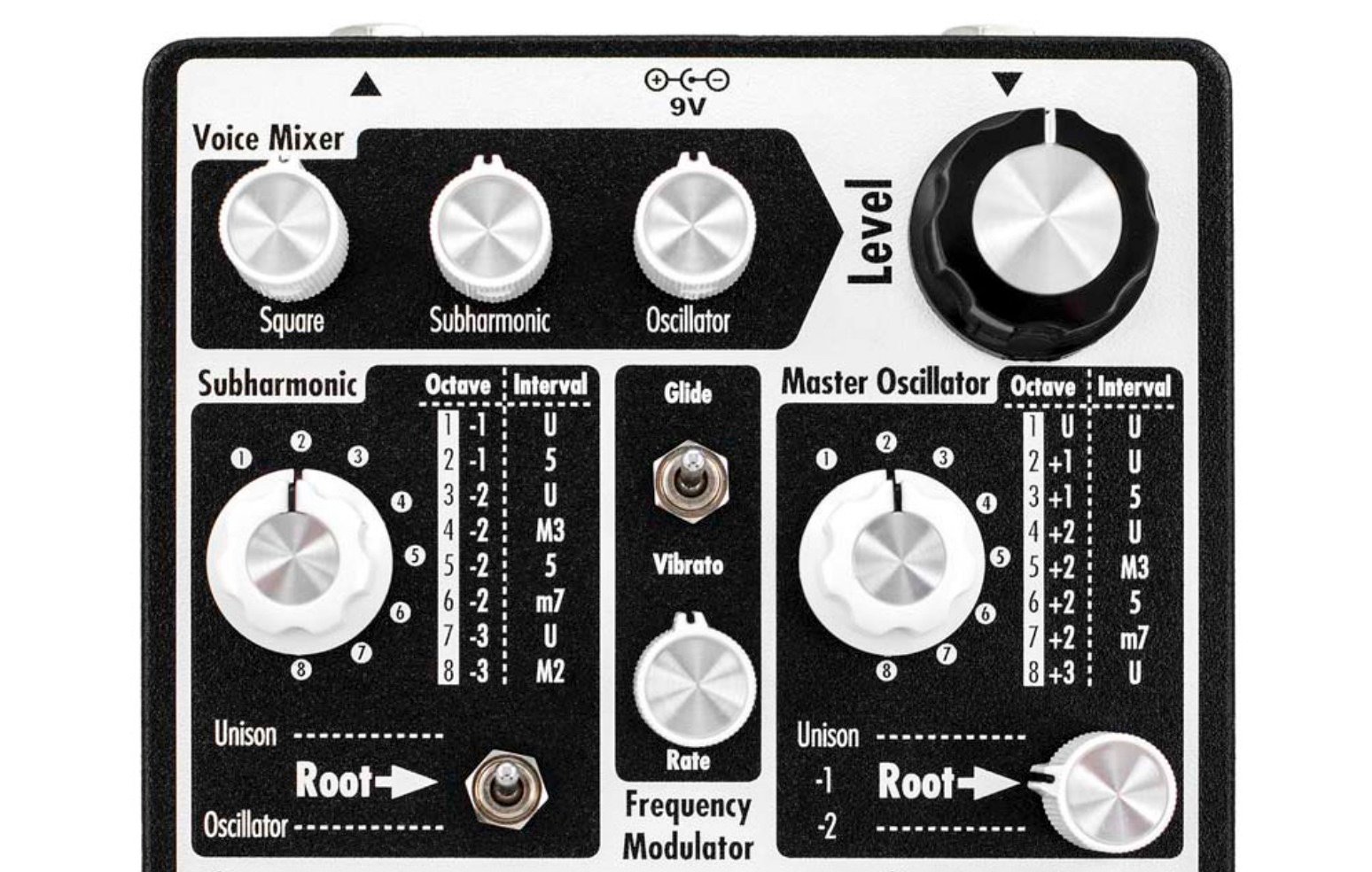
The Master Oscillator derives its pitch from the square wave fuzzed-out version of your input signal. What's particularly interesting is that the Master Oscillator also lets you multiply your instrument's frequency by a number of pre-set values up to three octaves above the original pitch. From there, you can use the corresponding Root control to offset the shifted pitch down by up to two octaves, allowing a wide range of timbres and harmonies when mixed with the direct Square sound. The Subharmonic Oscillator is similar—however, rather than multiplying your instrument's frequency, it divides it, allowing harmonies that track below your instrument's pitch (up to three octaves below). Alternatively—and this is one of the ways that things can get particularly weird—the Subharmonic Oscillator can be set to track the Master Oscillator rather than the Square signal, compounding the two to create a weird labyrinth of simultaneous pitch-tracked harmonies with a huge (like, eight octaves huge) pitch range. The Frequency Modulator section provides two flavors of pitch modifications with variable rate control—Glide, which introduces lag to the pitch response (most notably increasing the length of the "dive bomb" sound at the end of notes), and Vibrato, which does everything from wide pitch sweeps to tight, laser-like vibrato.
So on paper, that might not seem so bad; it's a square wave fuzz and two oscillators that can track and/or harmonize the square wave fuzz in a variety of ways. Arguably though, reducing Data Corrupter to that level of simplicity misses the point entirely: PLLs aren't a Boss-style synth effect with pristine tracking. Rather than tightly tracking your input sound, Data Corrupter is clumsy, sloppy, glitchy, and outright brutal...and while you can get it to track relatively well by sending in single-note lines with darker tones (it actually works fairly well using a guitar's neck pickup with your tone rolled all the way back), really, the magic is about making the most of its instabilities. This becomes particularly clear when running non-guitar signals through it...try sending synths, noise, field recordings, or drum machines through for an absolutely kaleidoscopic onslaught of chirps, glitches, gnarly pitch sweeps and distorted gremlin-like sputters. (Oh, and if you want to get some The Locust-like bass lines, this is your one-stop tone shop.)
And then there's Spatial Delivery, a filter pedal that goes from smooth and liquid to edgy resonances and classic sci-fi computer sounds. Combining Jerry Garcia-esque envelope filter tones with some of the more peculiar character of the Digitech Space Station, it is the perfect tool for turning your guitar into a classic quacking envelope filtered tone or something much more peculiar and synth-like.
Spatial Delivery features three distinct modes, with three parameters each. Two controls have a consistent function from mode to mode: Resonance and Filter. The Resonance control adjusts the filter's resonant peak, with subtle response when CCW and much more liquid, whistling tones with the resonance control turned up. The Filter knob is a continuous control for the filter type, with highpass response fully CCW, bandpass in the center, and lowpass fully CW. This is already a notable feature well beyond the capabilities of most envelope filter pedals—rather than focusing in on lowpass/bandpass quacks/sweeps and wah-like sounds, it allows you access to airy highpasses, blended filter type zaps, and all sorts of novel new sounds.
From there, each mode differs a bit from one another. The first two modes are pretty easy to wrap your head around—Up Sweep and Down Sweep. These are dynamic wah/filter-style effects that cause the filter's cutoff frequency to change in tandem with the dynamics of the incoming sound. In Up Sweep mode, you get classic envelope filter response, in which your playing dynamics cause the filter's cutoff frequency to increase. With lowpass or bandpass sounds, this can give you classic funk and jam band tones; with a highpass response, though, this has the fascinating effect of note attacks being relatively thin, with the sound opening up or "blooming" as your notes decay. Down Sweep has the opposite effect, with your playing dynamics causing the filter's cutoff frequency to lower. This is great for synth-like zaps when using lowpass or bandpass responses, or for creating notes with hard attacks that thin out and fizzle as they decay when using a highpass response. In both Up and Down Sweep modes, the Range control affects the envelope sensitivity—how quickly and how intensely the filter tracks your playing. My first impulse with this pedal was to dial in more extreme zaps and sweeps by cranking the Range control...but in actuality, you can dial in a load of subtlety here, creating synth bass-like muted tones, long-form filter sweeps that build with your playing, or whistling ambiences that sound ever-so-slightly unstable.
The last mode is perhaps the weirdest and most interesting: Sample & Hold. In this mode, rather than the filter's cutoff frequency being dynamically controlled, it is constantly modulated by a stepped random voltage, emulating classic modular synth tones from the prog rock and sci-fi of yesteryear. The stepped random filter sound is something of a cliché in the synth universe (albeit quite a nice one), but when introduced to the world of guitar effect processing, it takes on a new life. For instance, in the synth world, it's common to think of filters purely as a way of sculpting the harmonic content of a spectrally rich sound...but in the guitar world, it's a common practice for filters and wahs to come before distortion effects in the signal chain. Placing Spatial Delivery before a distortion creates insane, constantly shifting distortion effects; and in S&H mode, this can turn even humble one-note guitar lines into growling, robotic walls of aggressive tone. On the other hand, treating it more like a synth filter and placing it after distortion/fuzz/etc. can have the effect of making a guitar much more synth-like, or of adding clean, focused resonance to your sound.
Personally, I'm a huge fan of combining glitched-out, weird synth pedals with filter pedals to make guitars and other sound sources much more synth-like. As such, Data Corrupter and Spatial Delivery make an excellent pairing for my purposes. By placing Spatial Delivery after Data Corrupter, you're recreating a classic oscillator-into-filter synth architecture, but what's particularly interesting in this context is that Data Corrupter is much more unstable and dynamically responsive than typical synth oscillators (who often comfortably drone along with highly precise pitch and constant wave shape). Combining Data Corrupter's imperfections and highly sensitive response with Spatial Delivery's dynamic responsiveness and out-there S&H effects, you can create a synth sound that seems much more human and much wilder than your typical Moog synth. Or, you know, you can run any old sound through and have a heck of time blasting out some outrageous, aggressive, extraterrestrial noise. All approaches are equally valid!
Earthquaker's Endless Depths
Frankly, if you want a list of every interesting Earthquaker pedal, you should just look at a list of everything they make. In a more extensive review, we couldn't ignore the huge peculiar chords of the Organizer, the enormous ambiences of Astral Destiny, the twangy metallic sweeps of Pyramids, the crushing distortion of Bit Commander, the elegant simplicity of Tentacle, the powerful utility of Swiss Things, and so on.
One of the most consistently astonishing things about EQD is that, despite their size and success, they still maintain the spirit and feel from their roots as a boutique manufacturer. The pedals are hand-made, have a ton of character, and most importantly—none of them were designed to simply fill an audience's demands. Instead, each of their devices provides a novel way of approaching the effect at hand, imbuing simple reverbs with spiraling, effervescent peculiarities, chorus with outrageous modulation, synthesis with inspiring glitches and instabilities. There's a sense that every pedal takes its basic premise and pushes it as far as it can go, which for us is where their magic lies. Each design leaves plenty of range into the weird, unknown corners of sound manipulation...making them endlessly fascinating tools we'll continue to use for years to come.



